Did you know that pickled celery offers more than just a tangy flavor? The process of pickling this versatile vegetable not only preserves its crunchiness and tanginess but also provides several benefits. Whether you’re a pickle aficionado or a health-conscious individual, homemade pickled celery is a delightful treat that you can easily make in your own kitchen. Let’s dive into the world of pickled celery and explore its endless possibilities!
Key Takeaways:
- Homemade pickled celery is a tangy and flavorful treat that you can easily make at home.
- Pickled celery not only adds a unique taste to dishes but also provides several benefits.
- It’s a great way to preserve celery and enjoy its crunchiness and tanginess for an extended period.
- Pickled celery can be used in various dishes and as a healthy snack.
- Stay tuned to learn how to pickle celery and discover the fascinating role of celery seed in pickling!
How to Pickle Celery: A Step-by-Step Guide
Pickling celery is a simple process that anyone can master. Here’s a step-by-step guide on how to pickle celery:
- First, gather your ingredients. You will need:
- Celery stalks
- Vinegar (such as white vinegar or apple cider vinegar)
- Water
- Salt
- Sugar
- Spices (optional, such as garlic, dill, or mustard seeds)
Experiment with different spices and flavors to find your favorite pickled celery recipe. The possibilities are endless!
Whether you want to add a tangy twist to your salads or create a deliciously crunchy snack, pickled celery is a versatile and flavorful addition to your culinary repertoire.
The Flavor Profile of Celery Seed in Pickling
Celery seed is a key ingredient that greatly influences the flavor of pickled celery. When present in pickling spice blends, it adds a distinctive taste that is slightly bitter, earthy, and reminiscent of celery, but more concentrated. The unique flavor profile of celery seed enhances the complexity and deliciousness of homemade pickled celery.
The bitterness of celery seed provides a counterpoint to the tanginess of pickled vegetables, creating a harmonious balance of flavors. Its earthy undertones add depth to the pickling brine, elevating the overall taste experience. The concentrated essence of celery seed enhances the natural flavors of the vegetables, resulting in a highly satisfying and aromatic pickling experience.
Combining celery seed with other spices in pickling spice blends is like conducting a symphony of flavors. These blends typically include ingredients such as mustard seed, black peppercorns, coriander seeds, and cloves, among others. Each spice contributes its unique essence, creating a balanced and well-rounded taste in pickled celery.
Example Pickling Spice Blend:
| Ingredient | Amount |
|---|---|
| Celery Seed | 2 tablespoons |
| Mustard Seed | 2 tablespoons |
| Black Peppercorns | 1 tablespoon |
| Coriander Seeds | 1 tablespoon |
| Cloves | 1 teaspoon |
This example pickling spice blend showcases how celery seed serves as a foundational element. Its distinct flavor complements and enhances the other spices, amplifying the overall taste of pickled celery. The combination of these spices in pickling spice blends creates a delightful medley of flavors that tantalize the taste buds.
The Historical roots of Celery Seed in Pickling
The art of pickling has deep roots, with the use of celery seed dating back to ancient civilizations. In addition to its delightful flavor, celery seed was valued for its potential health benefits and preserving properties. Ancient cultures recognized the aromatic nature of celery seed, which not only enhanced the taste of pickles but also contributed to their long-lasting quality. The historical heritage of celery seed in pickling highlights its enduring role in elevating culinary creations and preserving the rich traditions of pickling heritage.
Looking back at the origins of pickling, it is fascinating to see how celery seed played a crucial role in ancient cultures. Let’s explore the historical significance of celery seed in pickling:
- Ancient Egyptian Cuisine: In ancient Egypt, celery seed was used as a popular spice in pickled foods. Egyptians highly valued the aromatic and flavorful nature of celery seed, incorporating it into their pickling recipes.
- Medieval Pickling Traditions: Celery seed continued to make its presence known in the Middle Ages. Medieval pickling techniques often included celery seed as a key ingredient, enhancing both the taste and preservation of pickled vegetables.
- Colonial America: When European settlers arrived in America, they brought along their pickling traditions, which included the use of celery seed. Celery seed became a staple in American pickling, adding its unique flavor profile to a variety of homemade pickles.
Through the ages, celery seed has remained an integral part of pickling heritage. Its distinct flavor and preserving properties have contributed to the evolution of pickling techniques and recipes. Today, we continue to embrace the historical roots of celery seed in pickling, honoring the traditions of the past while exploring new and creative ways to enjoy this tangy delight.
| Culture | Use of Celery Seed in Pickling |
|---|---|
| Egyptian | Valued for its aroma and flavor in pickled foods |
| Medieval | Incorporated into pickling techniques for enhanced taste and preservation |
| Colonial American | Brought by European settlers and used in various homemade pickles |
The Pickling Power of Celery Seed
Your homemade pickled celery is not only delicious but also owes its preserving capabilities to the mighty celery seed. This potent ingredient goes beyond adding flavor; it actively contributes to the preserving process, ensuring your pickles remain fresh and flavorful for an extended period.
Celery seed brings a unique combination of slightly bitter and peppery notes to the tangy brines used in pickling. This harmonious blend creates a balanced and well-rounded taste that elevates the flavor profile of pickled celery.
Furthermore, celery seed adds an aromatic intensity that enhances the overall sensory experience of consuming pickled vegetables. With every bite, you’ll discover a delightful burst of fragrance that complements the tanginess of the brine and the crispness of the celery.
But it doesn’t stop there. Celery seed also serves as a crucial agent in preserving the flavors and textures of celery during the pickling process. It helps maintain the crunchiness and vitality of the vegetable while infusing it with its distinct peppery essence.
If you’re curious about the scientific aspects of the preserving process, celery seed contains natural compounds that inhibit the growth of bacteria and other microorganisms. These properties ensure the longevity of your pickled celery, allowing you to savor its bold flavors whenever you desire.
“Celery seed is like a secret ingredient in pickling. Its preserving power keeps the flavors intact, allowing you to enjoy your homemade pickled celery for months.”
The pickling power of celery seed is undeniably remarkable. Harness its potential in your homemade pickles to create a delicious and long-lasting treat.
| Benefits of Celery Seed in Pickling | Preserving Power |
|---|---|
| Enhances flavor with its slightly bitter and peppery notes | Keeps pickles fresh and flavorful for an extended period |
| Contributes to a balanced and well-rounded taste | Maintains the crunchiness and vitality of pickled celery |
| Adds an aromatic intensity to uplift the sensory experience | Inhibits the growth of bacteria and microorganisms |
Celery Seed in Dill Pickles: A Classic Reinvented
Celery seed is a key ingredient in dill pickles, giving them their iconic flavor. In the realm of dill pickles, celery seed acts as a silent maestro, orchestrating a perfect balance of savory and aromatic notes. It enhances the natural taste of cucumbers and elevates them beyond simple brined vegetables. The addition of celery seed transforms dill pickles into culinary delights that are loved by many.
When it comes to dill pickles, celery seed plays a starring role, infusing every bite with its distinct flavor. The subtle bitterness and earthiness of celery seed complement the tartness of vinegar and the freshness of dill, resulting in a harmonious medley of tastes. This classic combination has stood the test of time and continues to be a favorite among pickle aficionados.
The use of celery seed in dill pickles is not a mere afterthought but a deliberate choice that takes these pickles to a whole new level. It adds depth and complexity, making each bite an explosion of flavors. Whether you’re enjoying a dill pickle spear as a snack or adding sliced dill pickles to your sandwiches, celery seed is what sets these pickles apart from the rest.
So why not embrace the reinvention of this classic pickle? With the addition of celery seed, dill pickles become more than just a condiment – they become a culinary experience. Indulge in the tantalizing flavors of dill, vinegar, and celery seed, and savor the unique taste that only homemade pickled celery can provide.
Now that we’ve explored the reinvention of dill pickles with celery seed, let’s move on to the art of balancing flavors in sweet pickles in the next section.
The Balancing Act: Celery Seed in Sweet Pickles
Celery seed is a key ingredient in creating the perfect balance of flavors in sweet pickles. Whether it’s the classic bread-and-butter pickles or the tangy sweetness of sweet gherkins, celery seed adds a unique touch that tantalizes the taste buds. With its slightly bitter undertones, celery seed tempers the sweetness, creating a nuanced and sophisticated pickle that appeals to a diverse range of taste preferences.
When combined with the natural sweetness of the pickles, celery seed adds depth and character, elevating them to another level of deliciousness. Its subtle flavors create a harmonious symphony that enhances the overall experience of enjoying sweet pickles.
If you’re looking to add a twist to your sweet pickles, consider incorporating celery seed into your recipe. It’s a secret ingredient that will delight your palate and impress your friends and family.
Quotes:
I never knew the magic that celery seed could bring to sweet pickles until I tried it myself. It’s like a flavor balancing act that takes the pickles to a whole new level of deliciousness. – Jane Smith, Pickle Enthusiast
Why Sweet Pickles with Celery Seed are a Hit:
- Versatile Flavor: The subtle bitterness of celery seed complements the sweetness of the pickles, creating a well-rounded and balanced flavor profile.
- Nuanced Taste: The addition of celery seed adds depth and complexity, transforming sweet pickles into a sophisticated and flavorful treat.
- Appeals to Different Palates: The combination of sweetness and a hint of bitterness appeals to a diverse range of taste preferences, making sweet pickles with celery seed a crowd-pleaser.
Whether you enjoy them on sandwiches, as a side dish, or straight from the jar, sweet pickles with celery seed offer a delightful taste sensation that’s hard to resist.
| Sweet Pickle Varieties | Flavor Profile | Key Ingredients |
|---|---|---|
| Bread-and-Butter Pickles | A perfect balance of sweet and tangy flavors | Cucumbers, onions, sugar, vinegar, celery seed |
| Sweet Gherkins | Crunchy and mildly sweet with a hint of tartness | Small cucumbers, sugar, vinegar, celery seed |
| Spiced Sweet Pickles | A medley of warm spices with a sweet and tangy taste | Cucumbers, sugar, vinegar, cinnamon, cloves, celery seed |
As shown in the table above, different sweet pickle varieties benefit from the addition of celery seed, creating a delightful flavor combination that will leave you craving more.
Celery Seed in Ethnic Pickles: A Global Culinary Voyage
When it comes to pickling, celery seed is not bound by traditional practices alone. It embarks on a global culinary voyage, leaving its unique imprint on various ethnic pickling traditions. From the zesty Indian achar to the aromatic pickled vegetables of Mediterranean cuisine, celery seed adds its versatile touch to an array of pickles around the world.
In Indian cuisine, the bold flavors of pickled vegetables, collectively known as achar, take center stage. These tangy and spicy delicacies are often made with a combination of fruits and vegetables. Celery seed adds its distinct flavor profile, contributing to the complexity and depth of these beloved Indian pickles.
The Mediterranean region boasts a rich pickling heritage, with pickled vegetables being an essential part of mezze platters, salads, and sandwiches. Celery seed, with its earthy notes, perfectly complements the flavors of pickled cucumbers, peppers, radishes, and other Mediterranean vegetables. It adds a touch of depth and complexity to these pickles, making them an irresistible culinary delight.
In Southeast Asian cuisine, pickled vegetables play a key role in balancing flavors and adding a refreshing touch to meals. Celery seed finds its place in these vibrant and diverse pickles, harmonizing with the bold spices and tangy brines used in Thai, Vietnamese, and Indonesian cuisines. Its versatility shines through as it seamlessly blends with a variety of flavors, enhancing the overall taste experience of ethnic pickles.
Throughout the world, different cultures have their own unique pickling traditions, often featuring local vegetables and spices. Whether it’s the fiery kimchi of Korea, the tangy sauerkraut of Germany, or the delicate pickled cherry blossoms of Japan, celery seed has the ability to adapt and elevate the flavors of various ethnic pickles.
Celery seed in ethnic pickles transcends borders, adding depth, complexity, and a global twist to a beloved culinary technique. As you explore the world of pickling, don’t hesitate to incorporate this versatile ingredient and embark on a flavorful journey of your own.
Homemade Pickle Creations: Embracing Celery Seed in Your Kitchen
When it comes to homemade pickling, the possibilities are endless. It’s a chance to let your creativity shine and create unique flavors that suit your taste preferences. And one ingredient that can truly elevate your homemade pickles is celery seed.
As you venture into the world of pickling, celery seed becomes your ally, offering a canvas for your pickling creativity. It’s the secret weapon that adds an extra layer of deliciousness to your pickles and allows you to experiment with different combinations and ratios. Let celery seed be your guiding star as you embark on a pickling journey in your own kitchen.
Unleash Your Creativity with Different Vegetable Combinations
One of the joys of homemade pickling is the ability to combine different vegetables and create unique flavor profiles. You can pick and choose your favorite vegetables or get adventurous with new ones. From cucumbers and carrots to radishes and onions, the possibilities are endless.
By adding celery seed to your pickling brine, you infuse each vegetable with a burst of flavor, enhancing their natural taste and creating a harmonious blend of flavors. The slightly bitter and earthy notes of celery seed perfectly complement a wide range of vegetables, giving your pickles a depth that is unmatched.
Experiment with Spice Ratios and Brine Formulations
Another way to embrace celery seed in your homemade pickles is by playing around with spice ratios and brine formulations. You can adjust the amount of celery seed based on your personal preference to achieve the perfect balance of flavors.
Whether you prefer a more pronounced celery seed taste or a subtle hint, it’s all in your control. You can also explore different spice combinations and brine formulations to tailor your pickles to your liking. The versatility of celery seed allows you to create pickles that are uniquely yours.
Discover New Flavor Profiles and Enjoy the Delights of Homemade Pickled Celery
With celery seed as your ally, you can unlock a world of flavor profiles in your homemade pickles. From tangy and zesty to spicy and aromatic, the combinations are endless. Each jar of pickles becomes a culinary adventure, offering you a taste of something new and exciting.
| Pickling Tips | Benefits |
|---|---|
| Experiment with different vegetable combinations | Preserves the crunchiness of celery |
| Adjust spice ratios to suit your taste | Enhances the overall flavor of pickles |
| Try different brine formulations | Creates unique flavor profiles |
| Combine celery seed with other spices | Increases the versatility of pickles |
So, why not embrace the world of homemade pickles and enjoy the delights of pickled celery? With celery seed as your creative companion, you can create pickles that are truly exceptional and uniquely yours. Let your pickling creativity flourish and savor the tangy and flavorful wonders that await you in your own kitchen.
Conclusion
Pickled celery, with the addition of celery seed, is a tangy and flavorful treat that you can easily make at home. Its versatility as a snack and condiment makes it a delightful addition to a variety of dishes. The unique taste of homemade pickled celery elevates the flavor profile with its tanginess and crunchiness, creating a satisfying culinary experience.
Celery seed is the secret ingredient that enhances the flavor of pickled celery. Its distinctive taste, slightly bitter and earthy, adds depth and complexity to the pickling process. Celery seed plays a significant role in preserving the flavors and textures of the celery, ensuring a long-lasting enjoyment of your homemade pickles.
Whether you’re a fan of classic dill pickles or prefer the sweetness of bread-and-butter pickles, the addition of celery seed creates a symphony of flavors that will entice your taste buds. So, why not embark on the journey of pickling and relish the delights of homemade pickled celery? Explore different vegetable combinations, spice ratios, and brine formulations to create your own unique pickling creations. Let celery seed be your guide and enjoy the tangy and satisfying taste of homemade pickled celery.

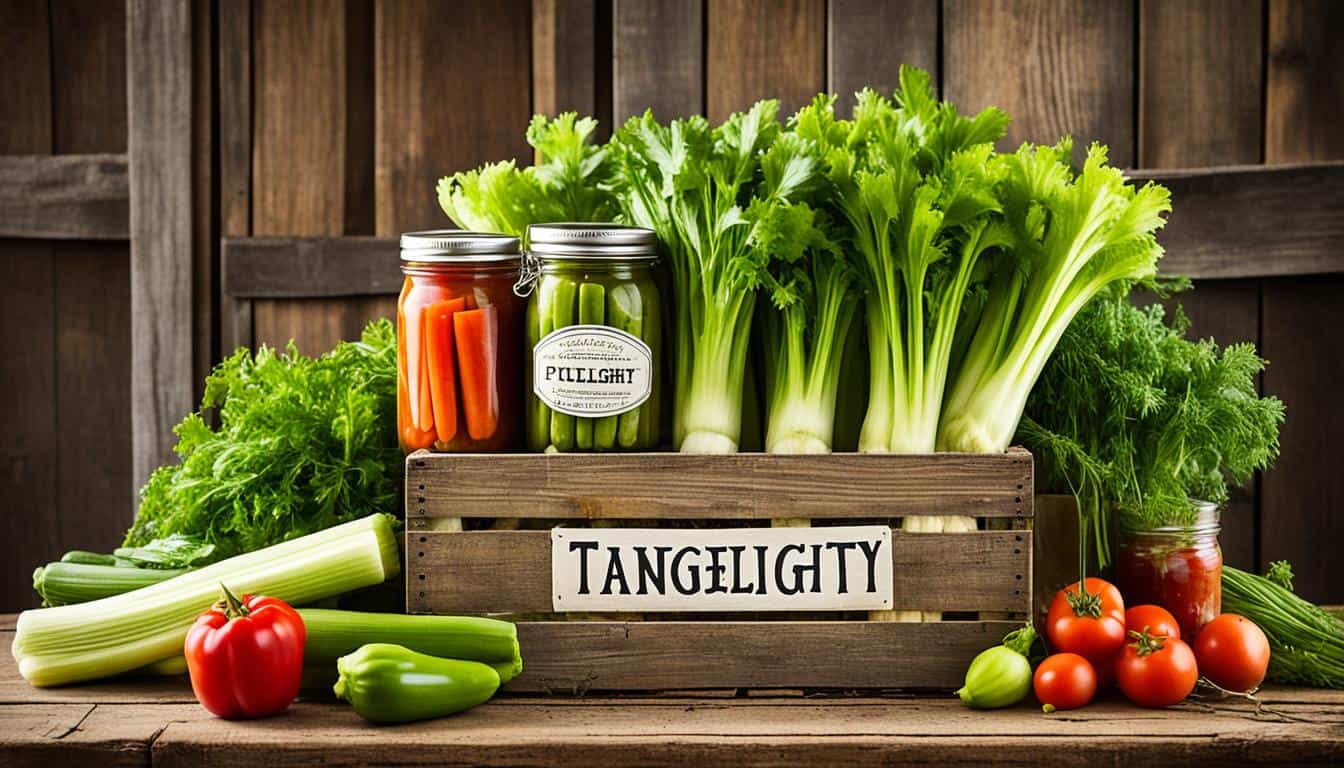
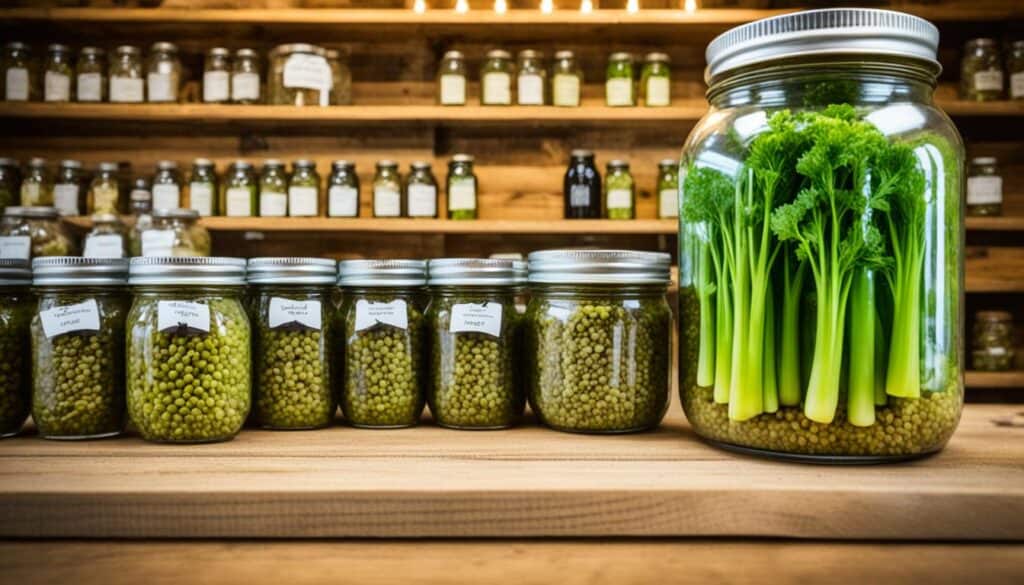
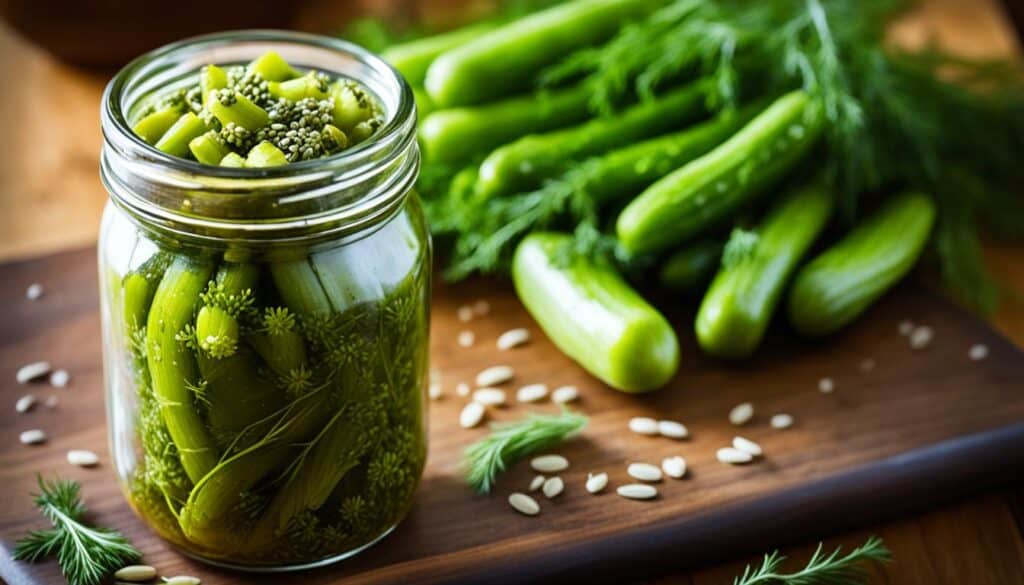
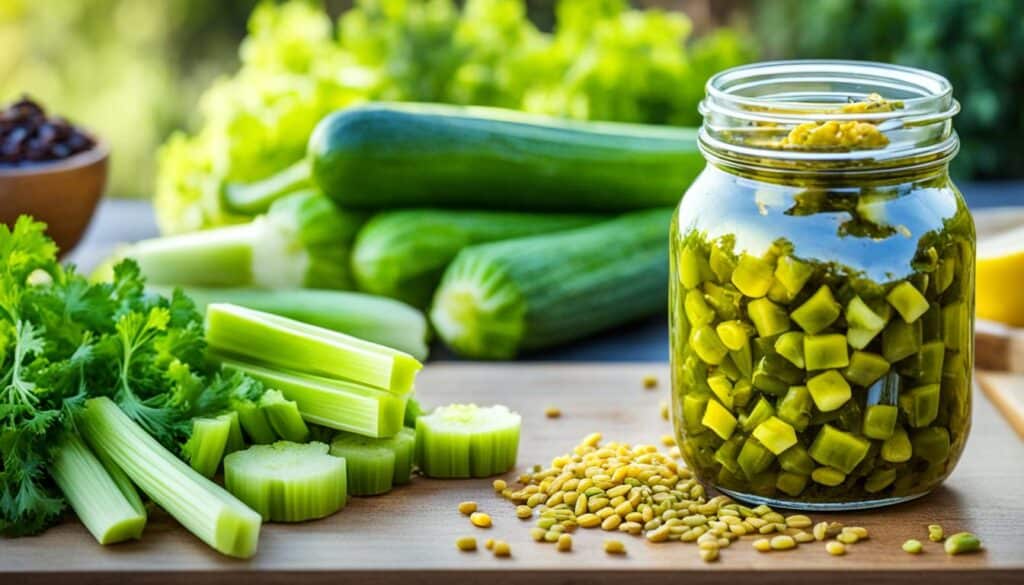
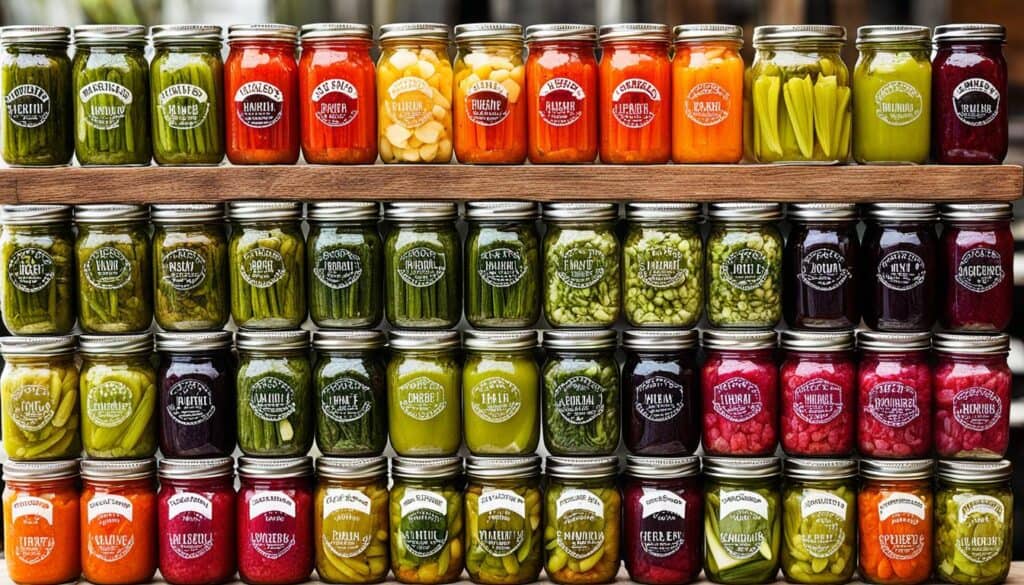
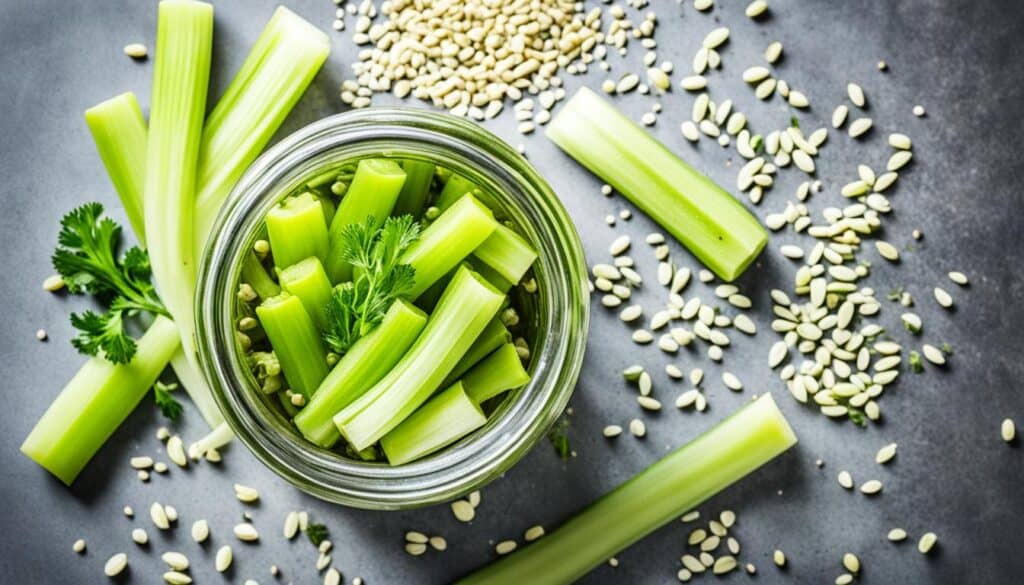

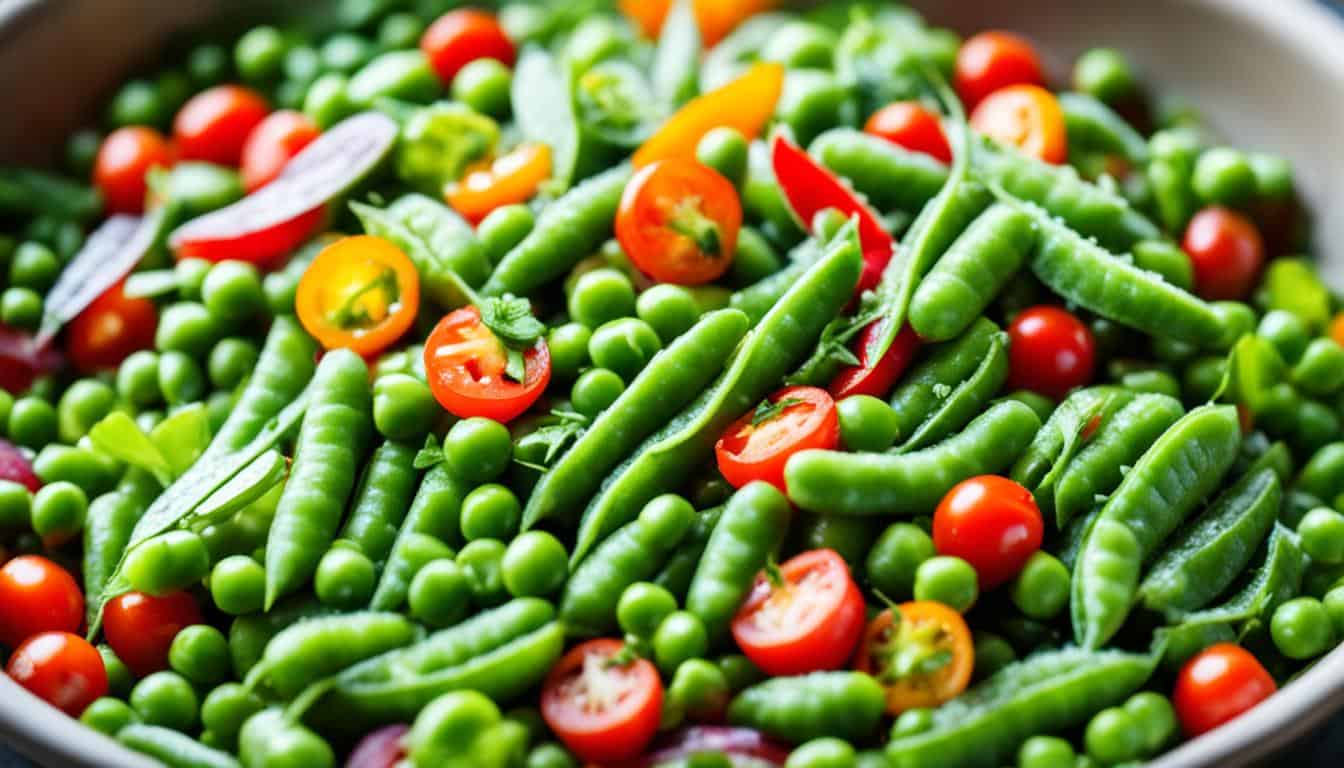
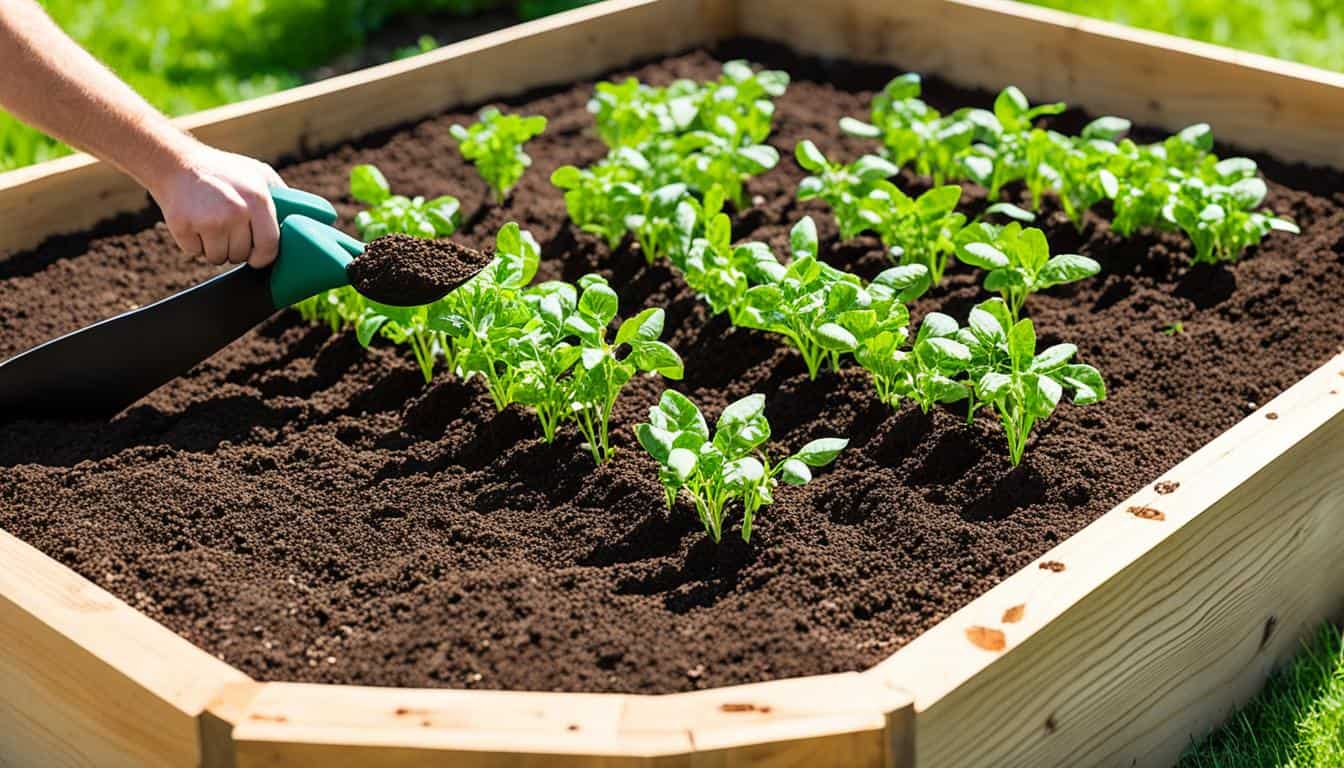
Leave a Reply